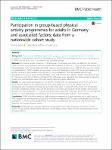Participation in group-based physical activity programmes for adults in Germany and associated factors: data from a nationwide cohort study
Jordan, Susanne
Krug, Susanne
von der Lippe, Elena
Background
Characteristics of different participation groups can provide important information to increase participation in group-based physical activity programmes (GPAPs). This study examined four types of participation in GPAPs and the factors that characterised these participant groups.
Methods
The present sample comprised 3219 participants. The analyses were based on data from the ‘German Health Interview and Examination Survey for Adults’ (t1) conducted in 2009–2011, which included 3959 people who had participated in the ‘German National Health Interview and Examination Survey 1998’ (t0). The outcome variable was participation in GPAPs, classified in four groups: ‘once at t1’ (participation only at t1), ‘twice’ (participation at t0 and t1), ‘once at t0’ (participation only at t0) and ‘no’ (no participation). Predictor variables were sex, age, educational level, income, sports activity, self-rated health and counselling for physical activity, measured at t0 and t1. Frequencies with 95% confidence intervals (CI) for each group were calculated. Four stepwise logistic regression models with estimated odds ratios (OR) were used to determine group differences.
Results
The largest participant group was ‘no’ (80.8%). Among those who participated in GPAPs, the ‘once at t1’ group was the largest (13.1%), followed by the ‘once at t0’ (4.0%) and ‘twice’ (2.1%) groups. ‘Once at t1’ participation was associated with female sex (OR 2.58), being active in sports (OR 6.59), a high level of education (OR 1.88). If additionally health status and the physician’s counselling are included into the models, then having fair/poor/very poor health (OR 1.71) and having had physician counselling on physical activity (OR 2.50) are relevant factors. For ‘twice’ participation, being female (OR 5.19) and practising sports (OR 4.51) were predictors.
Conclusions
GPAPs should be tailored to build on previous experience of sports activities and to reach men as well as people with low education, groups that have been the least reached. To reach more people and encourage participation in GPAPs, providing opportunity for physician counselling for physical activity may be promising, especially with groups of poorer health.

